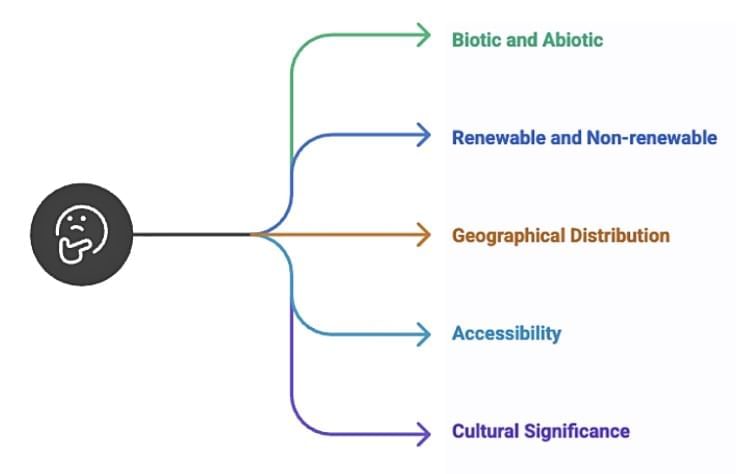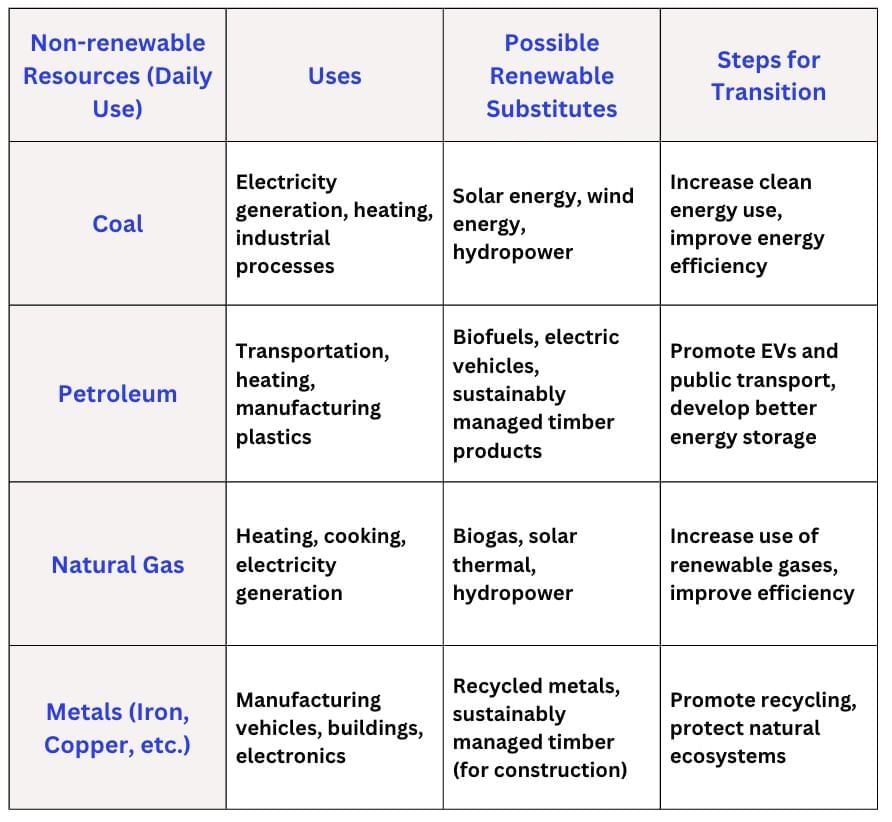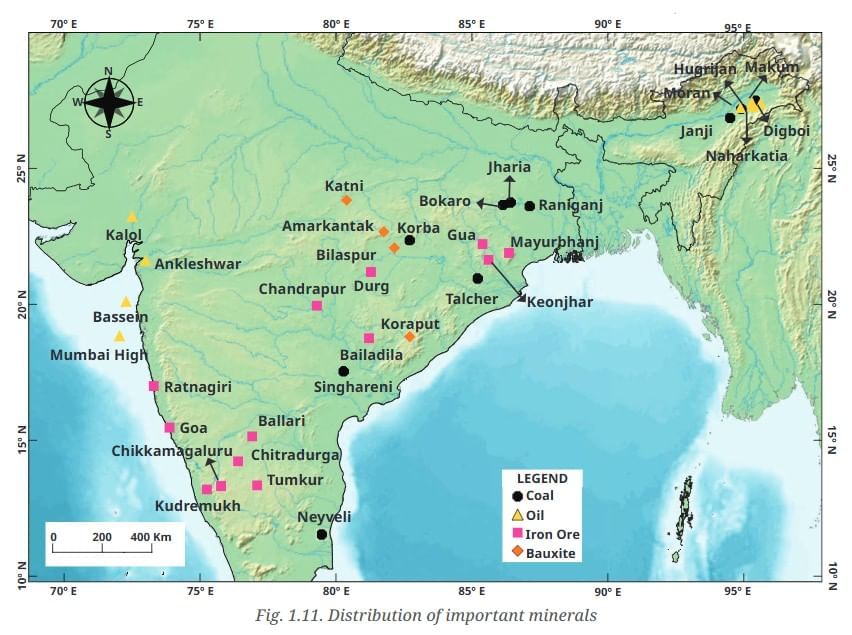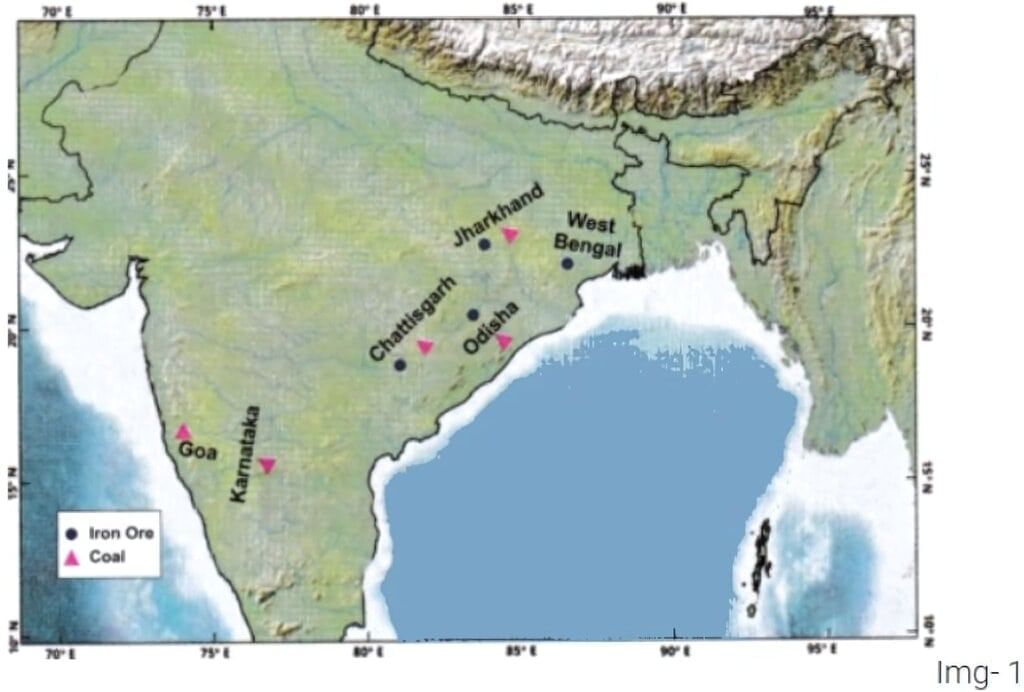Natural Resources and their Use NCERT Solutions | Social Science Class 8 - New NCERT PDF Download
| Table of contents |

|
| The Big Questions |

|
| Think About It |

|
| Don’t Miss Out |

|
| Let’s Explore |

|
| Questions and Activities |

|
The Big Questions
Page No. 1
Q1: How do We Categorize Natural Resources?
Ans: Natural resources are elements found in the environment that humans use for various purposes. They can be categorised based on their use and renewability.
1. By use:
- Essential resources: Air, water, and soil are crucial for life.
- Material resources: Wood, coal, and metals are used to create products.
- Energy resources: Solar, wind, and fossil fuels generate electricity and power industries.
2. By renewability:
- Renewable resources: Timber, water, and solar energy can regenerate over time.
- Non-renewable resources: Coal, petroleum, and minerals are limited and take millions of years to form, making them difficult to replace once used.
Q2: What is the Connection Between the Distribution of Natural Resources and Different Aspects of Life?
Ans: The distribution of natural resources significantly influences various aspects of life:
- Human settlements: Areas rich in resources attract industries, leading to economic growth and job creation.
- Trade: Resource availability shapes trade patterns, facilitating local and international commerce.
- International relations: Unequal resource distribution can cause conflicts over access, particularly for vital resources like water and minerals.
- Infrastructure development: Resource-rich regions often see better infrastructure, enhancing the quality of life.
- Disparities: Some areas benefit more from their resources, leading to inequalities in living standards.
Overall, while resources can drive growth, their unequal distribution can also lead to significant challenges.
Q3: What Are the Implications of Unsustainable Use / Over Exploitation of Natural Resources?
Ans: Unsustainable use or over-exploitation of natural resources can lead to serious long-term issues:
- Resource depletion: Overuse can exhaust resources, leaving fewer options for future generations.
- Ecosystem damage: Ecosystems suffer, which affects biodiversity and natural habitats.
- Shortages: Excessive use of renewable resources, like water and soil, can hinder their natural regeneration.
- Community impact: Local communities that rely on these resources for their livelihoods may face economic challenges.
- Wider issues: Over-exploitation contributes to climate change, pollution, and potential conflicts over remaining resources.
Addressing these implications is crucial for ensuring a sustainable future.
Think About It
Page No. 3
Q1: Take a pause. Look at yourself and the things around you. What is the origin of each of them? At some point they all lead to Nature; even the plastic button on your shirt.
Ans: Everything around us, from our clothes to the technology we use, originates in nature. Even a plastic button on our shirt comes from fossil fuels like petroleum and natural gas. Fabrics such as cotton and wool are derived from plants and animals, while buildings are constructed from timber, stone, and metals mined from the Earth. The energy we rely on, whether it be coal, wind, or sunlight, also comes from nature. In summary:
- All materials and products connect back to nature.
- Natural resources are vital for our survival and well-being.
- We must use these resources wisely and sustainably for future generations.
Page No. 4
Q2: What might be the different criteria we can use to categorise natural resources?
Ans: Natural resources can be categorised in many ways. They may come from living things, called biotic resources, like plants and animals, or from non-living things, including water, air, and minerals. One key way to divide them is into renewable types like sunlight and wind, and non-renewable ones like coal and oil. They can also be classified by where they are found. For example, coal and oil exist only in certain places, while sunlight and wind are available almost everywhere. Another way to categorise them is by how easy they are to access. Surface minerals are easy to get, while oil deep under the ocean requires special technology. Finally, some hold cultural or religious importance, such as sacred rivers or forests.
Don’t Miss Out
Page No. 3
Q1: Do you know of practices that reflect this?
Ans: Yes, many traditional practices show respect for Nature as sacred. In India, sacred groves are protected forest areas where cutting trees or harming wildlife is not allowed, as they are believed to be home to gods or spirits. Rivers like the Ganga are worshipped and seen as holy. Certain trees, such as the peepal and banyan, are also considered sacred and are not cut down. Indigenous groups in other countries, like Native Americans and Aboriginal Australians, hold similar beliefs and perform rituals to honour nature. These practices reflect care for the environment and a deep respect for natural resources.
Page No. 6
Q2: Do you know of other traditional practices that help the ecosystem to stay in balance?
Ans: Yes, many traditional practices show respect for Nature as sacred.
- Sacred groves in India are protected forest areas where cutting trees or harming wildlife is prohibited, as they are believed to be the homes of gods or spirits.
- The Ganga River is worshipped and regarded as holy.
- Certain trees, like the peepal and banyan, are considered sacred and are not cut down.
- Indigenous groups, such as Native Americans and Aboriginal Australians, share similar beliefs and perform rituals to honour nature.
These practices reflect a deep respect for the environment and natural resources.
Let’s Explore
Page No. 7
Q1: Identify human actions in your surroundings that result in Nature losing her ability to restore and regenerate. What types of interventions can be undertaken to restore Nature’s cycle?
Ans: Human actions that harm Nature's ability to restore and regenerate include:
- Deforestation: Cutting down trees faster than they can regrow.
- Water pollution: Contaminating rivers with industrial and household waste.
- Over-extraction of groundwater: Taking more water than can be naturally replenished.
- Excessive use of chemicals: Using too many fertilisers and pesticides that degrade soil health.
These activities disrupt natural processes, causing problems like soil degradation, water contamination, loss of biodiversity, etc.
To restore Nature's balance, we can:
- Plant native trees: This helps rebuild forests and supports local wildlife.
- Practice sustainable water management: Techniques like rainwater harvesting can conserve water.
- Reduce pollution: Properly treat waste before disposal to protect ecosystems.
- Use organic farming methods: These avoid harmful chemicals and promote soil health.
Implementing these measures supports the natural restoration and regeneration of ecosystems, allowing them to recover over time.
Page No. 8
Q2: Take up a small research study to assess the types of renewable resources in your region; you may discuss with your teacher the geographical area of your study and sources to access information that you may need. What has been the change in their status over time? Make a small report that identifies the reasons for the change and what may be done.
Ans: Do it Yourself
Suggestive Answer: In my region, Delhi, the primary renewable resources are solar energy, wind energy, and biomass. Solar energy has grown with government incentives, but adoption is limited by high costs and space constraints. Wind energy is underdeveloped due to the city’s flat terrain, and biomass remains untapped due to inefficient waste management. Delhi is working to increase its renewable energy capacity through initiatives like rooftop solar panels and projects such as a 1,000 MW solar plant and a 111 MW wind power plant.
The status of these resources has changed due to urbanisation and rising energy demand. While solar energy is growing, pollution and overcrowding reduce its efficiency. Wind energy has not progressed, and biomass potential remains unused. To improve, Delhi needs stronger policies for solar adoption, better waste-to-energy systems, and urban planning focused on renewable energy.
Q3: What are the non-renewable resources that you use daily, directly or indirectly? What are the possible renewable substitutes? What are some of the steps we can take to transition to renewables?
Ans: Non-renewable resources that we use daily, either directly or indirectly, include coal, petroleum, natural gas, and metals like iron and copper. 
Page No. 9
Q4: Observe the map in Fig.1.11. Notice the uneven distribution of important minerals. What types of resources are available in your region? How are they distributed? Ans: Do it Yourself
Ans: Do it Yourself
Suggestive Answer:
The map illustrates that minerals are unevenly distributed across India. Key resources include:
- Coal: Predominantly found in eastern and central regions, such as Jharia, Raniganj, and Korba, as well as in the south at Neyveli and Singareni.
- Iron ore: Abundant in central, eastern, and southern parts, including Bailadila and Mayurbhanj.
- Bauxite: Mainly located in central and eastern India, particularly in Katni and Koraput in southern Odisha.
- Petroleum and natural gas: Found along the western coast near Mumbai High and Ankleshwar, and in the northeast at Digboi.
This uneven distribution reflects India's diverse geology, with certain regions rich in specific minerals. In my region, Jharkhand, several important minerals are present:
- Coal: The state is particularly rich in coal, with major coalfields in Jharia, Bokaro, and Dhanbad.
- Iron ore: Mainly found in the Singhbhum district.
- Other minerals: Jharkhand also has deposits of bauxite, copper, mica, and uranium, spread across various parts of the state.
Page No. 10
Q5: Select any two natural resources. Gather information about their availability across different parts of India. Mark them on a map. What do you observe about their distribution? What are the types of economic activities connected with them?
Ans:
Coal and iron ore are two important natural resources found in different parts of India. These are located in: 
The distribution of these resources is uneven, with significant deposits concentrated in the eastern and southern regions of India. This has resulted in:
- Growth of mining industries in these areas.
- Creation of jobs related to mining and processing.
Coal is used mainly for electricity generation and in industries, while iron ore is used to make steel, supporting construction and manufacturing activities.
Q6: Discuss the implications of extracting the natural resources in those parts for current and future generations. Suggest ways in which we can use Nature’s gifts in responsible ways.
Ans: The extraction of natural resources brings economic benefits but often leads to the displacement of communities, loss of cultural heritage, and environmental damage. Over time, it depletes resources, harms ecosystems, and creates sustainability challenges for future generations.
To use Nature’s gifts responsibly, it is essential to adopt sustainable extraction methods, prioritise renewable energy, and implement effective resource management. Supporting policies that promote conservation and respect local communities’ rights is crucial. Encouraging a circular economy, where resources are reused and recycled, helps reduce waste and ensures long-term sustainability. Educating future generations on the importance of preserving natural resources is key to safeguarding the Earth for the future.
Q7: Find out about such a conflict in the international context? Discuss your findings in the class.
Ans: Do it Yourself
Suggestive Answer: An example of an international conflict over natural resources is the ongoing dispute between Ethiopia, Egypt, and Sudan regarding the Nile River.
- Ethiopia has built the Grand Ethiopian Renaissance Dam (GERD) to produce electricity.
- Egypt and Sudan are concerned that this dam will limit their access to vital water supplies.
- Egypt relies on the Nile for nearly 90% of its water.
- Despite multiple negotiations, a lasting agreement has yet to be achieved.
This situation illustrates how shared natural resources, like rivers, can lead to significant tensions between nations.
Page No. 11
Q8: What do you think are the different inputs required to enable the use of the natural resources available in different geographical areas?
Ans: To effectively utilise natural resources in various geographical areas, several essential inputs are required:
- Skilled workforce: Individuals with the right knowledge and expertise are crucial for managing and developing resources efficiently.
- Good governance: Effective leadership ensures fair use of resources and helps prevent corruption.
- Strategic planning: Proper planning is necessary to avoid overdependence on a single resource.
- Infrastructure investment: Developing roads, electricity, and transport systems is vital for resource extraction and distribution.
- Modern technology: Advanced methods are needed for safe and effective extraction and processing of resources.
- Environmental sustainability: Caring for the environment and respecting local communities is essential for long-term viability.
- Market access: Countries must have the ability to sell resources and products at fair prices to convert natural wealth into sustainable development.
Questions and Activities
Page No. 19
Q1: What can make what is today a renewable resource non-renewable tomorrow? Describe some actions that can prevent this from happening.
Ans: A renewable resource can become non-renewable if it is consumed faster than it can regenerate. Key examples include:
- Overfishing: Removing fish from oceans quicker than they can reproduce.
- Deforestation: Cutting down trees faster than they can grow back.
- Groundwater extraction: Taking water from underground sources faster than it can be replenished.
To prevent renewable resources from becoming non-renewable, we can:
- Implement sustainable management practices.
- Control water harvesting to ensure natural replenishment.
- Reduce waste and use resources efficiently.
- Engage in restoration efforts, like reforestation and water conservation technologies.
By prioritising responsible practices in agriculture and resource management, we can safeguard the regeneration of these resources for future generations.
Q2: Name five ecosystem functions that serve humans.
Ans: Ecosystems provide several crucial functions that directly support human life and well-being.
These include:
- Oxygen Production: Trees and plants produce oxygen, essential for human survival.
- Pollination: Insects such as moths, flies, and other pollinators help in the reproduction of many crops and plants, supporting food production.
- Water Purification: Ecosystems like wetlands and forests naturally filter and clean water, ensuring access to clean resources.
- Climate Regulation: Ecosystems absorb carbon dioxide and produce oxygen, helping to regulate the climate and maintain environmental stability.
- Soil Fertility: Processes like decomposition and nutrient cycling in ecosystems support soil formation and fertility, which is essential for agriculture.
- Provision of Food: Ecosystems provide diverse food sources, including plants, animals, and fish, which are vital for human nutrition and survival.
Q3: What are renewable resources? How are they different from non-renewable ones? What can people do to ensure that renewable resources continue to be available for our use and that of future generations? Give two examples.
Ans: Renewable resources are natural materials that regenerate over time, such as sunlight, wind, water, and wood. Unlike non-renewable resources like fossil fuels and minerals, they are not exhausted when used responsibly, as they replenish naturally. Non–renewable resources, however, are limited and cannot be restored within a human timescale.
To ensure the availability of renewable resources for future generations, we can:
- Use clean energy sources, such as solar and wind power.
- Minimise waste and adopt sustainable practices, like responsible forestry.
For example:
- Installing solar-powered street lighting reduces reliance on fossil fuels.
- Replanting trees after timber harvests ensures the forest can regenerate.
Q4: Identify cultural practices in your home and neighbourhood that point to mindfulness in the use of natural resources.
Ans: In our home and neighbourhood, various cultural practices demonstrate a mindful approach to using natural resources:
- Sacred Trees: Trees like the peepal and banyan are considered sacred and are preserved, promoting tree conservation.
- Sacred Groves: Forest patches known as sacred groves are protected due to their spiritual importance, helping to maintain biodiversity.
- Eco-friendly Festivals: Traditional festivals use sustainable materials, such as banana leaves for serving food, clay for making idols, and natural dyes for decorations.
- Water Conservation: Rituals are performed to clean and honour water bodies like ponds and wells, encouraging the conservation of water.
- Sustainable Living: Practices such as fasting and simple living during religious observances promote reduced consumption and sustainability.
Q5: What are some considerations to keep in mind in the production of goods for our current use?
Ans: When producing goods for current use, consider the following key factors:
- Sustainability: Use renewable resources and eco-friendly materials to minimise environmental impact.
- Energy Efficiency: Focus on reducing carbon footprints by optimising energy use during production and transportation.
- Waste Reduction: Implement recycling and reusing practices to minimise waste generation.
- Ethical Sourcing: Ensure materials are obtained responsibly, supporting fair labour practices.
- Durability: Design products to last longer, reducing the need for frequent replacements.
- Community Support: Engage with local communities to enhance social sustainability and reduce transportation emissions.
|
31 videos|128 docs|7 tests
|
FAQs on Natural Resources and their Use NCERT Solutions - Social Science Class 8 - New NCERT
| 1. What are natural resources and how are they classified? |  |
| 2. Why is it important to conserve natural resources? |  |
| 3. How do human activities impact natural resources? |  |
| 4. What are some examples of renewable and non-renewable resources? |  |
| 5. How can individuals contribute to the conservation of natural resources? |  |
















